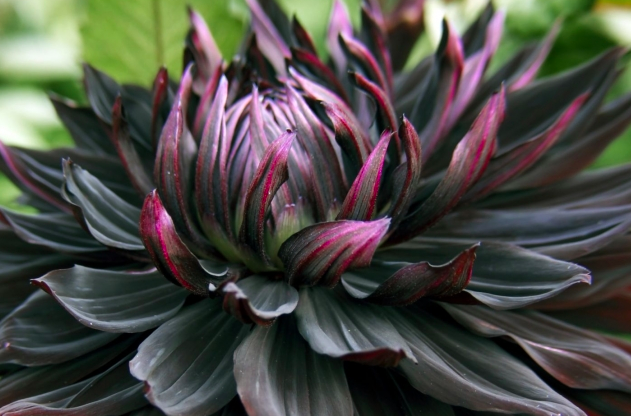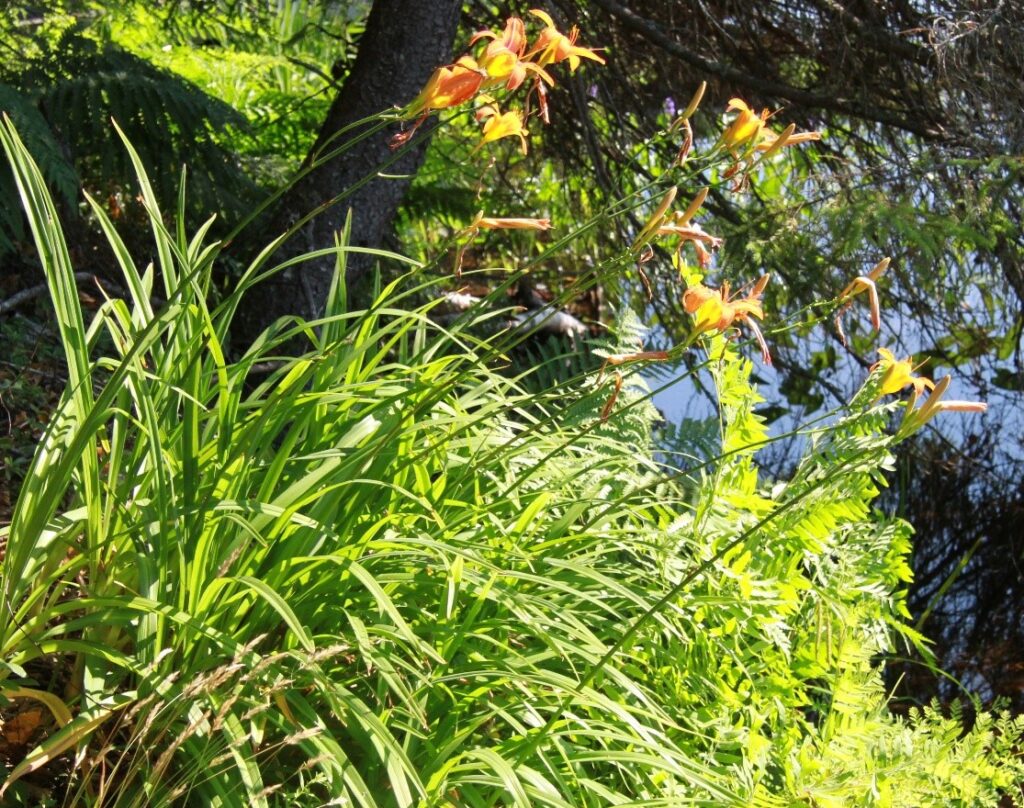
Goth Gardening – it’s partly about dark, rich foliage and blooms
When I first laid my eyes on a black petunia in the Spring of 2017, the velvety texture and depth captivated me. I’ve never seen a blacker bloom in my entire life! While growing that black petunia all summer, I was amazed at how it shrugged off the heat and bloomed from Spring to frost. After falling in love with that black beauty, I began noticing all kinds of cool plants with dark, rich foliage and blooms. That’s when I began to channel my inner Morticia Addams and dove deep into the dark world of black plants and Goth Gardening!
What is Goth Gardening?
 Plant collectors and breeders have been fascinated by black flowers for generations. In the Victorian era, collectors returned from Asia and South America with exotic new plant species. Those with dark blooms were much desired. As the fascination for black flowers grew, entire gardens were dedicated to dark flowers and foliage. [1]
Plant collectors and breeders have been fascinated by black flowers for generations. In the Victorian era, collectors returned from Asia and South America with exotic new plant species. Those with dark blooms were much desired. As the fascination for black flowers grew, entire gardens were dedicated to dark flowers and foliage. [1]
The Victorians created picturesque gardens that would be the equivalent to a fun-filled theme park in their day. The gardens were loaded with carefully orchestrated effects and morbid reflections of death. This included spiky rambling roses, poisonous plants, and brooding black blooms. To add to the morbid vibe, the gardens would be peppered with carnivorous plants. Gothic gardens drew crowds back then for the same reason horror movies grab our attention today – a good scare. [2]
However, many features of Gothic style can fit comfortably into a contemporary garden design without creating the atmosphere of a horror film.
Design Elements of Goth Gardening
 The Gothic Revival architectural style is characterized by slender vertical pillars and tall pointed arches, with an emphasis on height and open spaces. [3] Combined with the medieval love of decadent decoration and rich colours, the Victorians used this style in their architecture, furniture, fabrics, and gardens.
The Gothic Revival architectural style is characterized by slender vertical pillars and tall pointed arches, with an emphasis on height and open spaces. [3] Combined with the medieval love of decadent decoration and rich colours, the Victorians used this style in their architecture, furniture, fabrics, and gardens.
When designing my goth garden, I set the scene in a 2′ x 4′ raised cedar bed. The bed was slightly dilapidated (which added a bit of charm) and weathered to a nice warm gray. This would be the perfect place for my future eerie wonderland.
I wanted to evoke the mystery of the Victorian gardens, so I began to add Gothic architectural features such as pointed, arched trellises that mimic shapes seen in the majestic cathedrals of northern France. My garden wouldn’t be complete without a touch of Victorian romance so I looked for the perfect, small stone statue. Imagine how happy I was to find a concrete head planter by a local London artist Jill Emeny.
Pro Tip: If your concrete statue looks “new” paint it with yogurt to get a good growth of algae, making it appear older. I also spray-painted a lil’ garden gnome black for a touch of whimsy.
Plants
I like to fill my goth garden with black bloomed beauties that were popular with Victorians, especially those plants that are surrounded by legends and lore. Take a look at some of my favourites below. You can grow this selection easily here in zone 6. Be sure to do a little exploring on your own. You’d be surprised how many of your favorite blooms exist in a moody, brooding color.

Scabiosa, Black Knight
One of my personal favourite flowers is Black Knight Scabiosa, also nicknamed the “Mournful Widow” due to the somber black-burgundy tones. Beautiful beaded buds open to a sumptuous flower resembling a satin pincushion studded with white-tipped pins. The fragrant honey-scented flowers attract bees and butterflies to the garden.

Nasturtium, Black Velvet
The deepest colored Nasturtium out there is a variety called “Black Velvet” which has been selected for its mahogany-colored blooms veiled in black. Nasturtiums are edible and Black Velvet adds a glamorous color to my salads and cakes, as well as creating an eye-catching display in the garden. In Victorian times a similar variety was described as having dark blood-red flowers and curiously emitting electric sparks in the evening!

Nemophila, Penny Black
The Victorians loved this wildflower because of its dainty two-toned flowers and airy, light green foliage. I use this little gem as a gothically-minded border plant to frame my garden. The blooms are only the size of a pea but are such a charming accent. Bonus: Penny Black is super easy to grow!

Bachelor’s Button, Black Magic
This drought-tolerant, deep purple maroon is a refreshing new take on an old classic. Not only is it perfect in the goth garden but I like to use Black Magic as a cutting flower. It makes a striking accent in a bouquet with Cosmos, Delphiniums, and Coreopsis. The petals are also edible and make a stunning garnish. I’ve noticed that Black Magic attracts many pollinators, beneficial insects, and birds to the seed heads. If old blooms are left in the garden, they will naturalize and grow for you again the following year.

Basil, Purple Petra
Purple Petra is an inky-looking ornamental herb that is just as easy to grow as other basils. The leaves are an attractive dark violet. Don’t let the brooding color fool you, as Purple Petra has a mild, sweet taste that is perfect for those who love basil’s flavor but shy away from too much herbal spiciness.

Petunia, Ray Black
Adding major drama wherever it’s planted, the Black Ray Petunia is bathed in velvety black trumpet-shaped flowers with deep purple overtones at the ends of the stems. I use this variety to add magical black blooms in my spooky concrete planters nonstop, from Spring to mid-Fall. You can catch this beauty at Heeman’s Greenhouse.

Dahlia, Karma Choc
This sultry beauty is a favorite of goth gardeners. The chocolate-scented bloom is a velvety red and features dark foliage. I use these showstoppers to catch people’s attention. In the Victorian era, Black Dahlias were a favorite among gardeners and represented commitment. Black Dahlias were often gifted to newlywed couples.
Goth Gardens should be a sanctuary without too much maintenance. I love the look of untidy and unkempt plants in goth gardening. This can be achieved by forgoing regular maintenance like deadheading and pruning. Add a touch of goth doom and gloom by allowing some of your plants to keep their faded blooms. Seed heads can look hauntingly beautiful and will draw in hungry birds.
When your black blooms have been left to their own devices and the right atmosphere has been set, you’ll have a goth garden that would make even Morticia Addams swoon!
References
[1] Holly Rupert: Black Beauty
[2] Nikki Tilley: What is a Goth Garden
[3] Frank Organ: Get the Mystery of a Goth Garden for Yourself
http://8ff.ad6.myftpupload.com/gardening-trends-2019/





About The Author: Darlene Davis
Darlene's gardening expertise encompasses a range of areas, including organic gardening practices, pollinator gardening and flower farming. She is an experienced flower farmer with a wealth of knowledge in Floriculture. Darlene is an alumna of the University of Guelph's Horticulture program, as well as the Gardener's Workshop and the Floret Workshop.
More posts by Darlene Davis